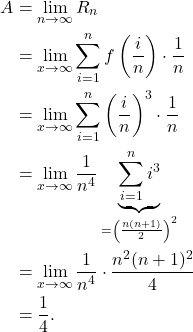Problem 248: The area ![]() of the region
of the region ![]() that lies under the graph of the continuous function
that lies under the graph of the continuous function ![]() is the limit of the sum of the areas of approximating rectangles.
is the limit of the sum of the areas of approximating rectangles.
(1) ![]()
Use the above definition to determine the expression that represents the area under the graph of ![]() from
from ![]() to
to ![]() , and evaluate the limit. That is, the Riemann sum is given by
, and evaluate the limit. That is, the Riemann sum is given by
(2) 
Since we are using rectangles of equal width,
(3) ![]()
Thus (2) takes the following form:
(4) ![]()
One can now find the ![]() . That is,
. That is,
(5) ![]()
One can now find the limit.
(6) 
That is, the area is
(7) ![]()

Leave a Reply